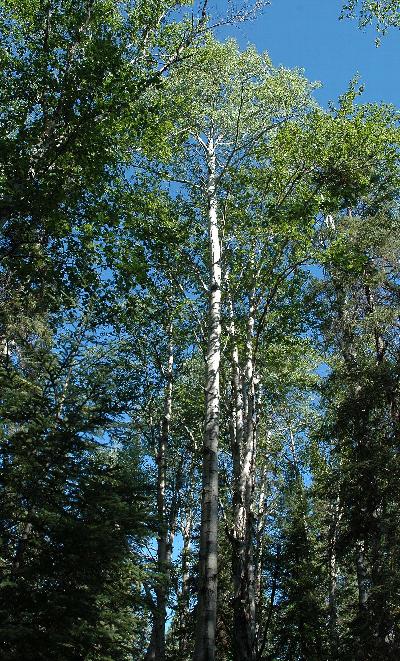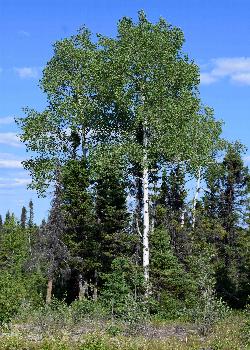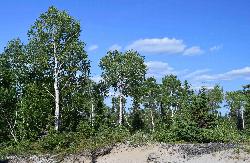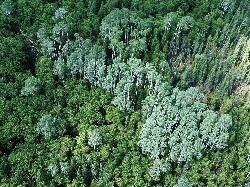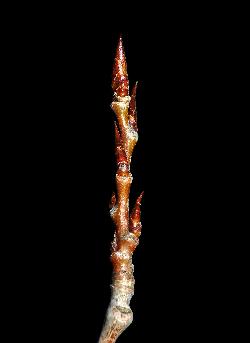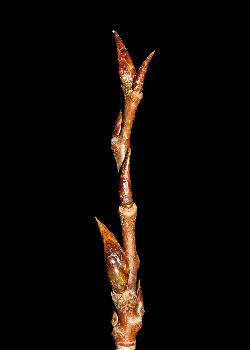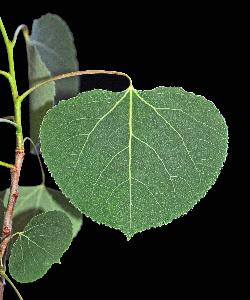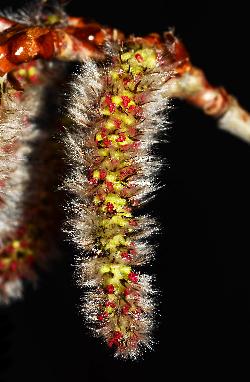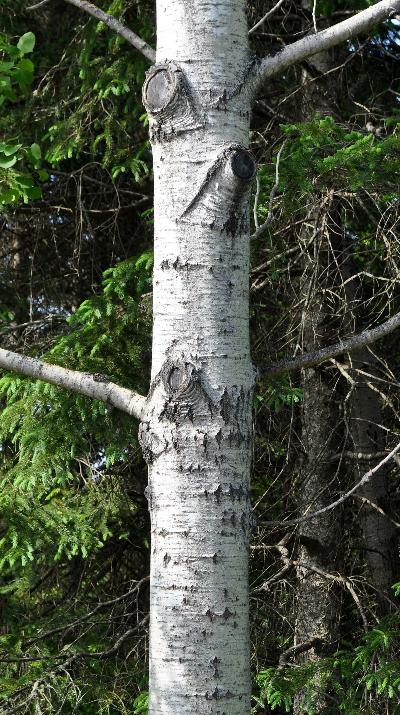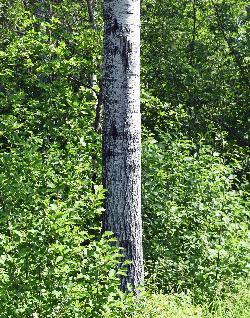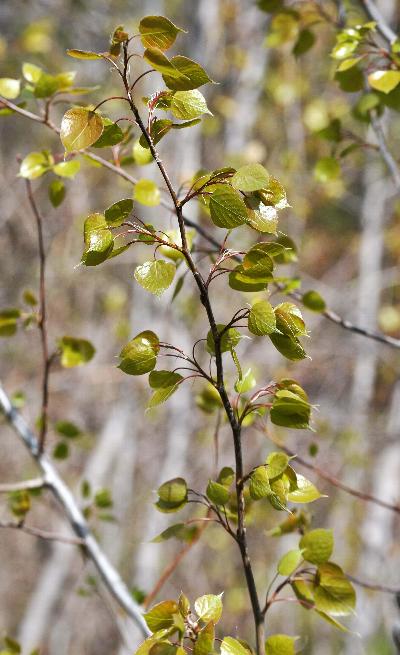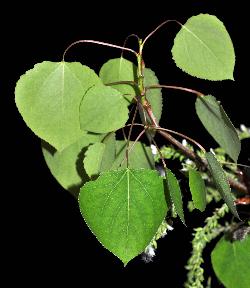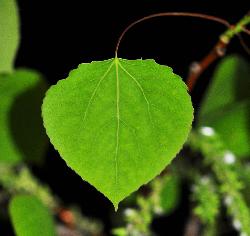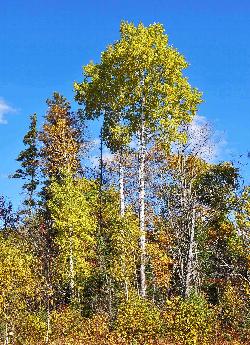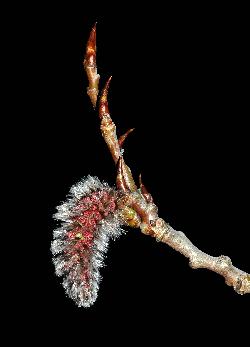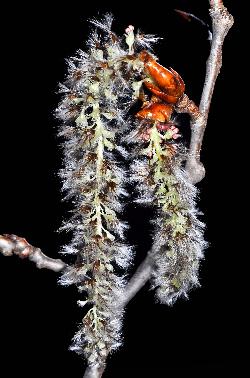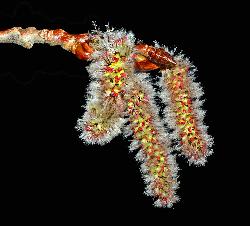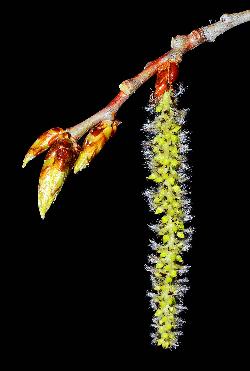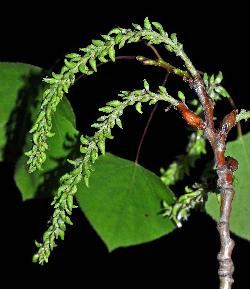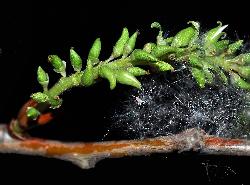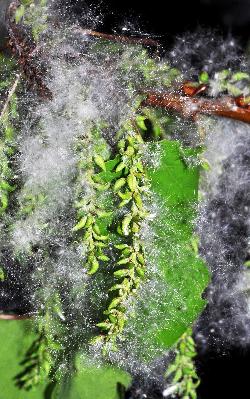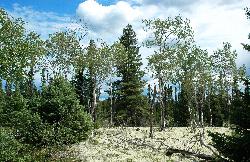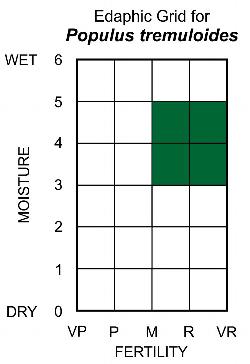Fr: peuplier faux-tremble, tremble, faux-tremble, tremble américain
IA: mitush
Salicaceae - Willow Family
Note: Numbers provided in square brackets in the text refer to the image presented above; image numbers are displayed to the lower left of each image.
General: A fast-growing medium-sized deciduous tree, with a slender straight trunk, reaching 25 m tall, with an average d.b.h. of 40 cm [1–2]; in very favourable sites, it can attain heights over 35 m and a d.b.h. larger than 130 cm (Perala 1990). Trembling aspen is a short-lived tree, reaching about 80 years of age; it is also shade-intolerant, with a shallow wide-spreading root system, and is a pioneer species that quickly colonizes disturbed sites [3–4]. Trembling aspen often reproduces asexually, forming dense clones [5], which are populations of trees that develop from root sprouts of the parent tree (the genet), particularly after disturbance, such as fire, damages or kills the parent tree (Perala 1990). Individual shoots/trees are called ramets and are genetically identical to the genet. Trembling aspen is a favoured food of beavers, who feed on the tender bark and shoots, as well as harvest trees for their dams and lodges. A variety of bird species also feed on trembling aspen, eating buds and drilling holes in the trunks in search of insects. In Labrador, porcupine will feed on the bark and shoots of aspen (Perala 1990).
Key Features:
- Buds are sharply pointed, only slightly resinous, and have the first bud scale situated directly above the leaf scar [6–7].
- Leaves are broadly ovate with a rounded to truncate base and taper abruptly to a short pointed (acute to acuminate) apex [8].
- are flattened perpendicular to the blade, allowing the leaves to flutter easily in the wind [9].
- Flowers are unisexual, arranged in pendant catkins, with male and female catkins on separate trees; flowers are subtended by deeply divided brown bracts bearing numerous silvery-grey hairs. Female flowers have an ovate superior ovary with 2 red stigmas [10]; the ovary is subtended by a shallow cup-shaped disk, most easily seen in the young fruit.
Stems/twigs: Twigs are greenish-brown to reddish-brown and glabrous; buds are alternate, scaly, and shiny, with 6–7 dark brown imbricate bud scales [6–7]. Terminal buds are lanceolate, sharply pointed (acuminate), slightly resinous, and 4–7 mm long. As in all poplars, the smaller lateral leaf buds have the first bud scale positioned directly above the leaf scar, which is elliptic and slightly curved with 3 bundle trace scars [7]. Flower buds are larger than the terminal bud, 6–10 mm long, and occur on lateral 1-year-old branches. Trunks of younger trees have smooth, non-shredding, greenish-white to light grey bark [11–12]; mature trees have light to medium grey bark with horizontal ridges and short diamond-shaped furrows [13–14]. Lenticels are horizontal and become more pronounced with age.
Leaves: Alternate, simple, palmately-veined with 3 main veins, and long-petiolate. Petioles are 1–6 cm long, often orange to red, and flattened at right angles to the leaf blade [9], causing the leaves to flutter in the wind. Immature leaves are glossy and slightly pubescent but glabrate [15], becoming glabrous at maturity. Mature leaf blades are broadly ovate, generally glabrous, except for short silky hairs along the margins, and measure 3–7 cm long and wide. Leaf blades are dark green or grey-green above; lower blade surfaces are paler green [16–17]. Leaf bases are rounded, very slightly cordate, or truncate; apices taper abruptly to a short point (acute); margins are finely toothed (crenate-serrate), with 18–40 irregular teeth on each side. Leaves turn yellow in autumn [18].
Flowers: Unisexual; plants dioecious, with male and female catkins on different trees; occasionally, perfect flowers are also found (Perala 1990). The densely-flowered catkins, with about 50–60 flowers, are pendant and emerge before the leaves; nectaries are absent. Both male and female catkins are long and slender, with flowers subtended by deeply dissected brown bracts bearing numerous silvery-grey hairs, which give the catkins a fuzzy appearance. Male catkins are 5–7.5 cm long, their flowers have 6–12 stamens attached to a cup-shaped disc; anthers are dark red to pinkish [19–21]. Female catkins are 4–10 cm long; female flowers have the perianth parts modified into a shallow cup-shaped disc that subtends an ovoid superior ovary with 2 carpels and 2 deep pink to reddish stigmas [22] that turn brown on the young fruit [23]; each female flower terminates a short-pubescent pedicel, 0.5–1.5 mm long. Poplar flowers are wind-pollinated (anemophily).
Fruit: Fruiting catkins are 10–12.5 cm long. Capsules are numerous and small, narrowly ovoid, green, glabrous, and 2.5–4.5 mm long [24–25]. Poplar capsules split into 2 halves (valves) and have 10–14 seeds, each topped by a tuft of silky white hairs [26]. When capsules dehisce, clouds of tiny wind-borne seeds form fluffy masses in the crown [27–28] before being dispersed by wind currents, traveling up to several kilometres from the parent tree (Perala 1990).
Ecology and Habitat: Trembling aspen occurs throughout Newfoundland and north to about 54° N in Labrador. It is a pioneer species that most frequently occurs after disturbance, including fires, landslides, and blowouts on sand dunes. It is most abundant in the warmest regions with wildfire history, such as the Churchill River Valley in Labrador [29] and throughout central Newfoundland. Trembling aspen is usually found in low abundance with birch in mature coniferous stands, but can form pure stands locally after disturbance on nutrient-rich seepage slopes.
Edaphic Grid: See image [30]: the Edaphic Grid for Populus tremuloides.
Forest Types: Trembling aspen is most commonly encountered in the following central Newfoundland forest types (Damman 1964; Meades 1976):
- Abietum hylocomietosum (Hylocomium-Balsam Fir Forest Subassociation)
- Abietum rubetosum (Rubus-Balsam Fir Forest Subassociation)
- Alnetum lycopodietosum (Lycopodium-Alder Swamp Subassociation)
- Populo-Betuletum papyriferae (Birch-Aspen Forest Association)
In Labrador, it has also been observed in the Fir-Spruce-Birch/Rich Herb Forest Type (Wilton 1965) and the Birch Forest Type (Foster 1984).
Succession: Trembling aspen is a characteristic pioneer species, most commonly occurring within the province as an early successional species after wildfire in central Newfoundland and central Labrador. Black spruce usually replaces it as the dominant species in the mature stages of stand development. Where black spruce regeneration is inadequate after fire, semi-permanent mature stands of trembling aspen may develop (Meades 1976). It is also common on unstable sand terraces in the Churchill River Valley in Labrador (Wilton 1965). Its regional distribution in areas of high fire frequency and high summer temperate is thought to be related to its requirement for high soil temperatures, necessary to initiate root suckers (Maini and Horton 1966).
Distribution: Within Newfoundland, trembling aspen is absent from the Northern Peninsula and generally in low abundance in other regions, except for the Central Ecoregion (Damman 1983). In Labrador, it is most abundant in the Churchill River Valley and southeast coast, but can occur up to 54° N latitude and west to about 64° W longitude (Wilton 1965). It is the most widely distributed tree in North America (Perala 1990), extending from Newfoundland and Labrador west along the northern tree limit to British Columbia, the Yukon, and Alaska. In the western United States, it occurs south into the Rocky Mountains, but has a very disjunct distribution south of Idaho. In the eastern United States, it extends from Maine west to Minnesota, barely extending into the Dakotas, and south into Indiana, Ohio, and northernmost West Virginia (Perala 1990).
Similar Species: Balsam poplar (Populus balsamifera L.) is the only other native poplar in Newfoundland and Labrador. It can be recognized by its ovate glabrous leaves, which have finely serrate margins and a bright white glaucous lower surface, often resin-stained to orange. Trembling aspen can hybridize with other poplar species, but no hybrids have been documented between trembling aspen and balsam poplar.


